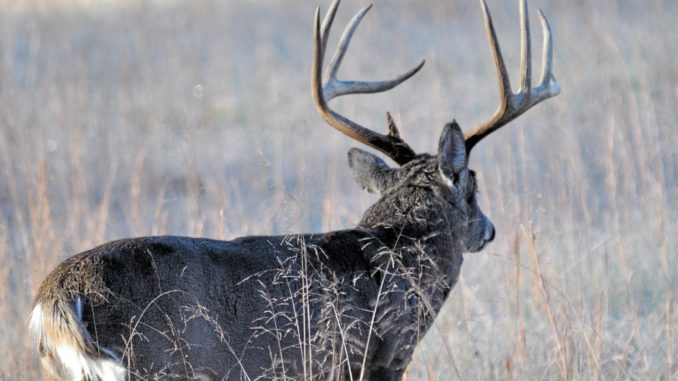
There’s still hope for a nice late-season buck if you take these experts’ advice.
Ninety-five percent of North Carolina hunters agree that bagging a whitetail with a sizeable rack is more difficult during December than any other month.
Several reasons exist for this condition:
• After three months of pressure from the state’s 275,000 licensed hunters, survivors have learned to avoid wide open spaces);
• Deer become primarily nocturnal feeders in December;
• More wary of humans for good reasons they make themselves scarce, and;
• Few agricultural crops remain in fields to pull deer from their hiding places.
But every coin has two sides, and so it is with late-season deer. Knowing the positives can put a hunter in the right place to put a tag on a December trophy.
They include:
• Whitetails that roam at night bed down at daybreak but usually rise near mid-day to get a sip or two of water and browse on plants and leaves before returning to their beds;
• With little natural food left, food plots often lure deer into the open;
• December is a good time to set up a climbing stand near emerald-green oats or wheat-field plots;
• North Carolina allows baiting of whitetails. So when woods are painted in browns and grays and tree limbs are bare, scattering shelled corn or cob corn on the ground near deer trails often draws deer like a magnet;
• The secondary rut starts 28 days after November’s primary rut. The second, shorter mating season begins in December and lasts 1 to 11/2 weeks. Bucks lose some caution when as they sniff out unbred does
Several N.C. hunters brought taxidermy mounts to the 2016 Dixie Deer Classic of bucks they’d shot during December 2015.
Most of them used one or more of the tactics already mentioned. One hunter employed a special tactic that didn’t involve placing a stand near a deer bedding area or food, didn’t use trail cameras, didn’t worry about the secondary rut and didn’t scatter bait on the ground. He simply outlasted his buck.
Covering all the bases
Joe Kindley Sr. of Rockingham N.C., manages 1,300 acres in Richmond County with his son, Joe Jr., and Dennis Holloway. The acreage has produced several trophy bucks, including an 8-pointer Holloway took in December 2015 that had a typical 4×4 mainframe and netted 1434/8 inches at the 2016 Dixie Deer Classic.
“I killed a buck the previous season that was a mainframe 10-pointer with only one odd point, a 3-inch kicker, that grossed 1596/8,” Kindley said. “So we’ve take two deer with large racks off the club’s property in last two years.”
Their secret?
“My son and I visit the property frequently throughout the year and put out a lot of (trail) cameras,. We rely on them a lot to find areas where (deer travel),”said Kindley, who said he also uses trail-camera photos to survey the herd and the quality of individual animals.
“Knowing helps us make decisions about the herd inside our 1300 acres.”
Kindley eliminates areas that don’t hold significant numbers of deer, especially shooter bucks.
“In summer, we look for trails, then in September we zero in on trails that lead to food plots or fields,” he said. “We also look for scrapes and rubs.”
The results of their trail-cam photos also allow them to make decisions about supplementing deer food.
“We put out protein (pellets), minerals and lots of other things to keep deer attracted to the farm and keep the herd healthy so we can have shooters,” he said. “My son and I put in a lot of seat time, too, just watching deer to see what we have.”
Only four or five hunters regularly hunt the property; Kindley said only three deer have been taken in each of the past four or five seasons.
In addition to protein pellets mixed with shell corn, food plots keep deer on the property all winter and offer plenty of trail-cameras subjects.
“We plant Imperial Whitetail Power Plant along with Magic Carpet, a blend of different (seeds) our deer seem to like,” Kindley said.
The Magic Carpet mixture includes soybeans, clay peas and some iron. Soybeans and clay peas contain protein and, with iron added, spur antler growth.
“We plant the Imperial Whitetail and Magic Carpet in spring, then (Imperial Whitetail) Pure Attraction and wheat in the fall,” he said.
Spring food plots help bucks’ antler growth, while winter plots, planted in early fall, are green during cold weather when natural and agricultural food sources have disappeared. Planted winter plots draw deer for hunters but add no antler growth.
But Kindley and his hunting buddies don’t rely on winter food plots. They set up corn-feeders at strategic spots, especially along well-used trails or around food plots that have cropped to the ground.
“We put out corn with feeders at those places,” Kindley said. “They work well in December. Our main focus is on managing our deer and not taking deer that are immature, so we can look at deer that come to feeders and not shoot young bucks.”
The secondary rut that occurs in December also helps club members get their sights on whitetails.
“It seems like the (November) rut is late some years, so the secondary is later in December where we hunt,” he said.
Dedication pays off
Familiarity may breed contempt, but for Mike Duke of Oxford, N.C., knowing the area he hunts has helped him bag December bucks.
“I’ve got a spot I’ve been hunting for 20 years and had a lot of success,” he said.
Duke took his biggest buck, a 10-pointer that scored 1433/8, last Dec. 29, from a stand on his Vance County hunting land.
“I was worried at one time somebody else had got him during bow, muzzloader or gun season because I saw him on a trail-camera (photo) once in October before I saw him again in December,” said Duke, who doesn’t have exclusive hunting rights to the 90-acre tract he hunts.
Duke’s biggest hunting asset is perseverance and spending as much time as he can in the woods once he locates a shooter whitetail.
“I don’t have food plots, and the land doesn’t have crops,” he said. “I also don’t use horns or deer scents. But I put out corn after the acorns get eaten up. I hunt acorns early; if acorns still are on the ground later, I don’t bother with corn because (deer) go to acorns first.”
Duke hunts six days a week, sometimes morning and evening, and he checks his trail cameras every day. The big buck was on camera twice, both times at night.
“But after the (secondary) rut, he started coming out of the pines closer to daylight, from 4 to 5 a.m., staying longer,” said Duke, who checked his trail camera on Dec. 26 and had an image of the big 10-pointer, taken at 5 p.m. He planned to hunt the stand that day, but he killed a doe closer to home and spent his time butchering the deer and packing it into his freezer.
Duke hunted the next two days without success, but on Dec. 29, he climbed into a platform stand near an old cutover, carring a Remington 1170 SuperMag shotgun loaded with 3 1/2-inch buckshot. The buck came to a corn pile at 5 o’clock, and Duke rolled him with one shot.
“If I can sit and wait at a stand, I can manage my herd and kill some nice bucks,” he said. “I really like cutovers, but that’s where the dog hunters go mostly, and there’s a lot of pressure I can’t control.”
Backyard bucks
With property-lease rates rising and many hunters parsing free time to second jobs and family responsibilities, Thomas Beasley Jr.’s tactic of hunting close to home on small tracts has become widespread.
Beasley used a scoped .308 rifle last December to nail a large Lee County 8-pointer within a mile of his home.
“I use one or two tactics because where I live it’s all posted (land),” he said. “But I’ve got a little place near my house.”
Beasley, who has been a hunt-club member — he said he spent “a lot of money and didn’t see anything.” — mainly scouts for trails leading to and from fields.
“Most of the time, I look for deer trails leading from soybean fields,” he said. “I throw up a stand about 100 yards in the woods from the edge, hopefully in oak woods, so I can catch deer coming down a trail toward a bedding area. I don’t put stands at field edges because deer can spot or hear you walking. I also might put out corn — or might not.”
He also doesn’t worry about the wind because he ratchets his climber stand as high as 30 feet.
“My main tactic is patience,” Beasley said. “I go up in a climber (stand) and sometimes stay all day.”

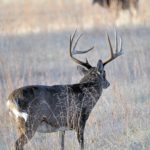
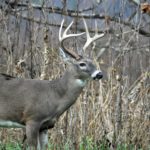
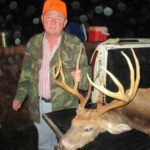
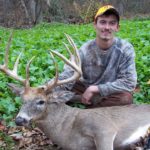



Be the first to comment